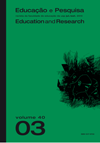Body education - social dance in 19th century Rio de Janeiro: the Paranhos point of view
DOI:
https://doi.org/10.1590/S1517-97022014005000004Abstract
Many authors consider 1850's as a turn point in Brazilian history. It was a period in which was conformed, in different areas, a stability that increase the process of the building of the independent nation. In the capital (Rio de Janeiro), which became a center that spread out new fashions and customs, was conformed a new social dynamics, a better structuring of the trade of luxuries and entertainments. By studying this period of Brazilian history, this article aims to discuss the educational aspects of one of the activities commonly promoted in Rio de Janeiro in the mid-nineteenth century, the social dance, considering the point of view of an important Brazilian Empire personality: José Maria da Silva Paranhos. This is a historical research that has used as sources 47 articles of this author, the series Letters to Absent Friend, published in the Jornal do Commercio between 1850 and 1851. It is concluded that the vision of Paranhos about the balls is directly related to his perception and his projects for the country. The dance events were perceived not only as a special fun, but also as occasions which helped to build and strengthen a civil society composed of different sectors of the national elite, which could lead Brazil to an auspicious future, marked by ideas of civilization and progress. Paranhos' view help understand the dances as a strategy for body education from three principles: effectiveness, ownership and identity.Downloads
Download data is not yet available.
Downloads
Published
2014-09-01
Issue
Section
Articles
License
Authors assume exclusive responsibility for the concepts expressed in their articles, which do not necessarily reflect the journal’s opinion.
Permission to photocopy all or part of the material published in the journal is granted provided that the original source of publication be assigned.
How to Cite
Body education - social dance in 19th century Rio de Janeiro: the Paranhos point of view . (2014). Educação E Pesquisa, 40(3), 751-766. https://doi.org/10.1590/S1517-97022014005000004



